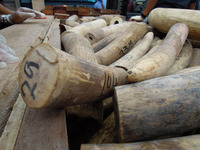Consumption, Endangered Species and Human Rights
Mar 5th, 2013 | By admin | Category: Consumption and WasteBy Suzanne York, www.howmany.org
An international conference on the Convention on International Trade in Endangered Species of Wild Fauna and Flora (CITES) kicked off this week in Thailand.
At the two week-long conference, delegates will address how to protect endangered plants and animals around the world by implementing a ban on the illegal trade of impacted species, including sharks, polar bears, African elephants, white rhinos, freshwater turtles, frogs, and crocodiles. A main item on the agenda will be the ivory trade.
 Since coming into force in 40 years ago, CITES has placed some 35,000 species of animal and plants under its protection, controlling and monitoring their international trade. Yet today the poaching of elephants, rhinos, and tigers and many other species is escalating (absurdly, demand for ivory is skyrocketing due to limited legal sales of ivory currently allowed under CITES).
Since coming into force in 40 years ago, CITES has placed some 35,000 species of animal and plants under its protection, controlling and monitoring their international trade. Yet today the poaching of elephants, rhinos, and tigers and many other species is escalating (absurdly, demand for ivory is skyrocketing due to limited legal sales of ivory currently allowed under CITES).
Trade in endangered species is a complicated issue. At its core it is based on unsustainable consumption, poverty, inequity, weak human rights, and globalization. The demand for ivory and other animal parts is pushing many to the brink of extinction:
- 32,000 elephants have been killed by poachers since the start of 2012;
- 3,000 great apes are killed or captured every year;
- there are fewer than 3,500 tigers left in the wild;
- humans kill about 100 million sharks each year, mostly for their fins.
It comes down to ending demand – through education and product bans – and changing the perception of many people who see nature only as a commodity.
For some people, it is the only way they know to earn an income. For others, it is a serious illegal business. The United Nations Environment Programme just released a report called Stolen Apes, which stated that “the illegal demand for apes is linked to organized crime and trans-boundary networks that move the animals in the same ways as drugs, arms and laundered money, making efforts to protect species that much more difficult.”
How can this consumption be curbed? That is the vexing question facing the CITES conference and really, all of humanity. Too many animals are on the verge of extinction. A nearly 100% ban on trade in endangered species is required, but it goes beyond that, to education, enforcement, economics, and empowerment.
Human encroachment and loss of natural habitats is also driving the illegal trade, pitting people against wildlife. In the Democratic Republic of the Congo, for example, the human population today is approximately 70 million; by 2050 the projection is for it to be 194 million people. 71% of the population lives below the poverty line.
Another factor impacting species is habitat destruction due to global demand for natural resources (oil, trees, metals).
Among its recommendations, the UNEP report urges increased enforcement of protected areas, to both reduce illegal trade and to protect habitat. More enforcement could lead to local jobs, which is needed. Beyond that, more must be done for the people, such as educating girls, empowering women, pulling people out of poverty, and creating sustainable livelihoods.
On the international level, there must be greater consumer education about the true costs of these products. As more people around the world become middle class consumers, greater numbers will want luxury (and cultural) products, many made from poached animals. In China, ivory is referred to as “white gold.”
While enforcement of international laws protecting species sounds great, the reality is that law enforcement for crimes related to illicit trade is lagging, according to the UN. More effective deterrents and severe sentences could help. But this should be in conjunction with providing sustainable economic alternatives and educational opportunities to communities to enable them to live in harmony with their environment.
For some good news, the prime minister of Thailand, under heavy pressure from environmental organizations, pledged at the start of the conference to end the nation’s ivory trade.
In his preface to the Stolen Apes report, Achim Steiner, Executive Director of UNEP, wrote “The illegal trade in wildlife makes up one part of the multi-billion dollar business that is environmental crime and is increasingly being perpetrated at the cost of the poor and vulnerable.” It is indeed a crime, and the bottom line is that the rights of people must be balanced with the rights of nature if we are to truly protect endangered species.
Suzanne York is a senior writer with the Institute for Population Studies
[illegal ivory photo credit: Elizabeth John / TRAFFIC]
[elephant photo credit: Deneys, http://www.flickr.com/photos/deneys/4285039505/]

